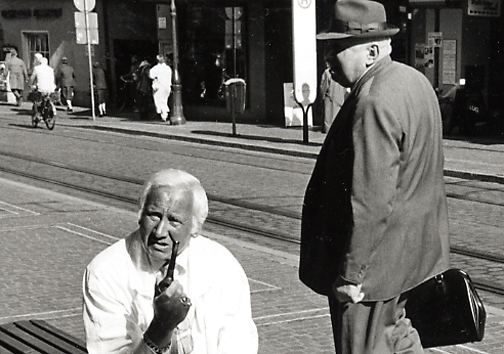Last summer found me back on the Schlossberg again, for the first time in twenty-five years. Nowadays a safety rail protects against potential picture-postcard suicides. The view over Freiburg and the Rhine valley - and beyond, the faint blue outline of the Vogues in Alsace, France - is still as pretty as a picture, still, a postcard view.
I run my hand along the safety rail as I follow the wall around the perimeter of the beauty spot until it turns inland, coming to an abrupt end at a ball and a bin. The mouth of the bin is stuffed with pizza cartons: spewing them out or taking them in? Tattooed across the bin’s forehead, Oral 1. A deranged umbrella with a bottle for a handle, lies, like a fallen woman with her skirt hiked up, or a wounded parachutist (brought down by flying-pizzas?), it’s broken limb cradled in a splint of pizza cartons, on the gravel, beside the bin.
This image unites two fellow travelers, Lautreamont, and Burroughs. First, an American housewife, from Burroughs’
Naked Lunch, ‘
And the Garbage Disposal Unit snapping at me, and the nasty old Mixmaster keep trying to get up under my dress’. Now, the famous image created by the Comte de Lautreamont: ‘
Beautiful as the chance meeting of a sewing-machine and an umbrella on a dissecting-table’.
All paths seem to lead here yet, there’s nobody about. I take a photograph, composing it in such a way that the three pizza cartons sticking out the mouth of the bin, chop into the tree on the left of the bin, in exactly the same way as the three graphitised white arrow signs in the background, penetrate the tree to the right of the bin.
But why do I make this nod towards formal symmetry, when Oral 1 says it all? Why am I so concerned about some pizza/sign interrelationship, when the message is writ large on the bin’s forehead? J.G. Ballard - also a great fan of Burroughs and Lautreamont - said, ‘Life is made up of half-remembered meals and unfinished conversations’: fast food and fast talk.
Now I’m off into Freibrug to see a man a man about an umbrella; a man who has neither, spoken or eaten for the last twenty-five years; a man who has stood still, a timekeeper clutching an umbrella, for whom, Time has stood still.
To be continued…












































